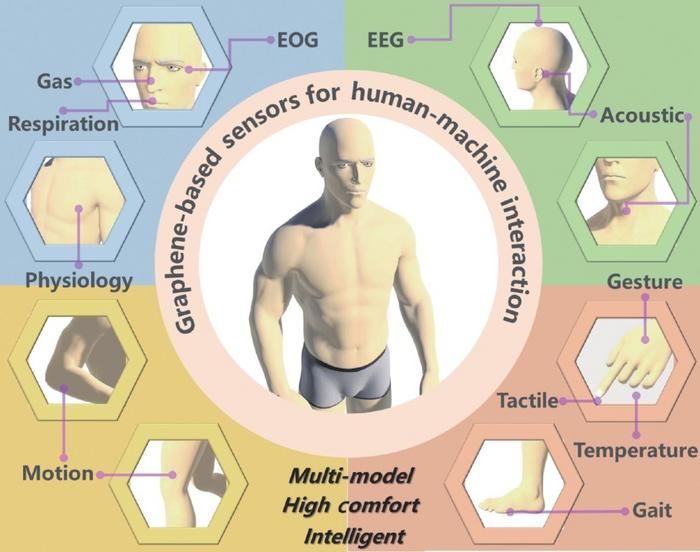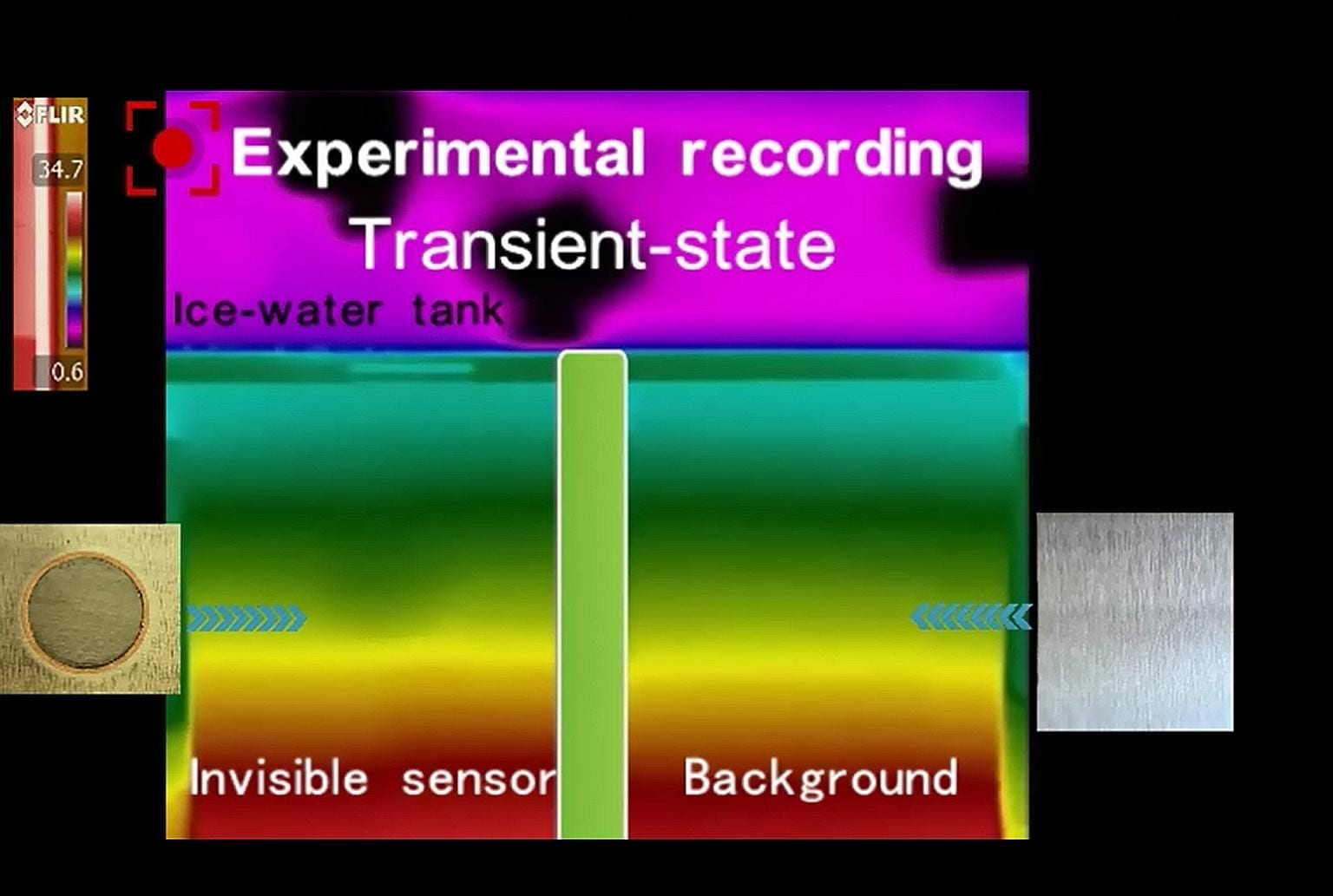
Small, comfortable graphene sensors can measure a variety of bodily signals, including respirations, vocalizations, temperature and gestures, through tests such as electroencephalograms (EEGs) that quantify brain waves and electrooculograms (EOCs) that measure eye movement.
CREDIT: Carbon Future, Tsinghua University Press
Interaction between machines and humans is paramount to the development of the new technologies of the metaverse, which are designed to augment the human experience through cloud computing and extended reality (XR). Graphene, a two-dimensional carbon material, has emerged as an ideal candidate for wearable sensor technology, paving the way for a new era of seamless human-machine interaction (HMI).
A team of material scientists led by Tian-Ling Ren from Tsinghua University in Beijing, China recently outlined the state of graphene-based HMI sensor technology to advance research in the field. Advanced sensor technologies that are flexible, lightweight and can be worn continuously are ideal for HMI and have potential applications in both the immersive virtual world of the metaverse and wearable healthcare technologies. Current research is aimed at creating sensors capable of interfacing nearly every part of the body that can be measured, including the brain, eyes and mouth. These measurements can then be used to characterize bodily information by an interfacing machine.
The team published their review in Carbon Future on August 13, 2023.
“In this review, we present an overview of some of our research team’s efforts to create graphene-based sensors for human-machine interfaces. These sensors, designed for use on various parts of the human body, are introduced with a focus on their target signals, design, manufacturing process and performance features. Additionally, we delve into potential future developments for graphene-based sensors, including multi-modality, improved comfort, and intelligence,” said Tian-Ling Ren, senior author of the review paper, professor in the School of Integrated Circuit and deputy dean of the School of Information Science and Technology at Tsinghua University. Dr. Ren is also the Yangtze River Scholar Professor of Chinese Ministry of Education and vice director of the Center for Environmental and Health Sensing Technology at Tsinghua University.
Graphene is made up of a single layer of carbon atoms arranged as a hexagonal lattice. The unique properties of graphene, including impressive conductivity, low chemical reactivity, flexibility and light weight, make the material an ideal candidate for human-machine interface sensor development.
The research team outlines the progress made in graphene-based sensors designed to measure a variety of different signals from the body. “Many parts of the human body, from head to toe, have the potential to be developed into human-machine interfaces. Brain, eyes, ears, nose, mouth, throat, fingertips, skin, joints, and feet can all be used as HMI interfaces based on electroencephalogram (EEG), electromyography (EMG), electrooculogram (EOG), eye movement, light, breathing, voice, touch, temperature, movement, gait and other physiological information,” Tian-Ling Ren said.
Humans can also benefit from output generated by machines, and development of multi-modal sensors that can alternate between signal measurement, such as sound perception, and signal output, such as sound generation, will be particularly useful for HMIs. Ren’s team demonstrated graphene sound production in a previous study. Tian-Ling Ren said, “With the help of machine learning, this interface can achieve speech recognition, emotion analysis, content processing, and more, making it ideal for intelligent robotic communication.”
One of the challenges of graphene-based sensor development is achieving a measurement range large enough to detect very dynamic senses, such as the sense of touch. To address this issue, graphene pressure sensors with a wide sensitivity range have been developed using loosely stacked laser-scribed graphene (LSG) films that increase in density with increasing pressure. The increased film density, in turn, causes a change in measured resistance with a range large enough to achieve high sensitivity.
The research team expects the review to spur development of new graphene-based sensors designed to facilitate more natural HMIs and improve real-time data collection and response in healthcare. “Graphene-based sensors for HMI are expected to become more diverse and practical in the coming years. In the same part of the body, the human and machine can interact with different signals… in many different ways,” said Tian-Ling Ren.
Original Article: Carbon-based sensors are poised to facilitate a seamless human-machine interface
More from: Tsinghua University
The Latest Updates from Bing News
Go deeper with Bing News on:
Carbon-based sensors
- A laser-based air quality monitor on every lamp post?
An EU-funded project called PASSEPARTOUT is developing a new gas-sensing network that can analyse multiple gasses in real-time. The system is sufficiently compact (‘hand sized’) and affordable (sub ...
- "Sentinel plants" could save crops via stress sensors in leaves
Specially tagged "sentinel plants" could soon provide an early warning of crop problems such as insect damage or bacterial infection. These plants would utilize two "glowing" sensors that react to ...
- The Science Behind Smart Home Sensors
Are you curious about the fascinating world of smart home technology? Are you eager to understand the inner workings of those nifty sensors that make our homes smarter and more efficient? Look no ...
- Scientists Harness Carbon Nanotube Sensors for Plant Signaling Detection
Researchers have developed carbon nanotube sensors to detect plant stress signals, offering a novel tool for farmers to monitor and respond to crop health threats in real-time.
- Sensors that detect plant stress could revolutionize farming
The team is working on integrating the plant sensors into diagnostic systems that could not only detect stress but also initiate responses.
Go deeper with Bing News on:
Graphene-based sensors
- Conductive Ink Market Is Encouraged to Reach USD 5.6 Billion by 2033 at a CAGR of 6.3%
According to Market.us, the Conductive Ink Market size is projected to surpass around USD 5.6 billion by 2033, from USD 3.5 billion in 2023, and it is poised to reach a registered CAGR of 6.3% from ...
- For The First Time, Scientists Capture The Protein-Lipid Dance on Video
Our bodies are alive with activity and packed with proteins jammed into fatty membranes or floating in and out of watery cells. Scientists have now, for the first time, captured the dance between the ...
- Vanadium Compounds in Emerging Electronics, Electrics, Cooling: Global Market Analysis and Technology Research Report 2024-2044
They will vary from 2D compounds, MXenes, graphene composites, vanadates, hollow nanospheres to intercalated cathodes, electrochromic windows and much more. Commercially-oriented analysis The 42-page ...
- Mechanical strain control of quantum transport in graphene enables new class of nanoelectronic devices
Their data again agreed with modeling based on the theory of strain-induced gauge fields in graphene. The results demonstrate that by employing strain as a knob to control electron wave interference, ...
- Laser-based sensor promises breakthrough in 3D printing
New laser-based sensing technology has been revealed and could change the quality assessment of critical metallic components ...










